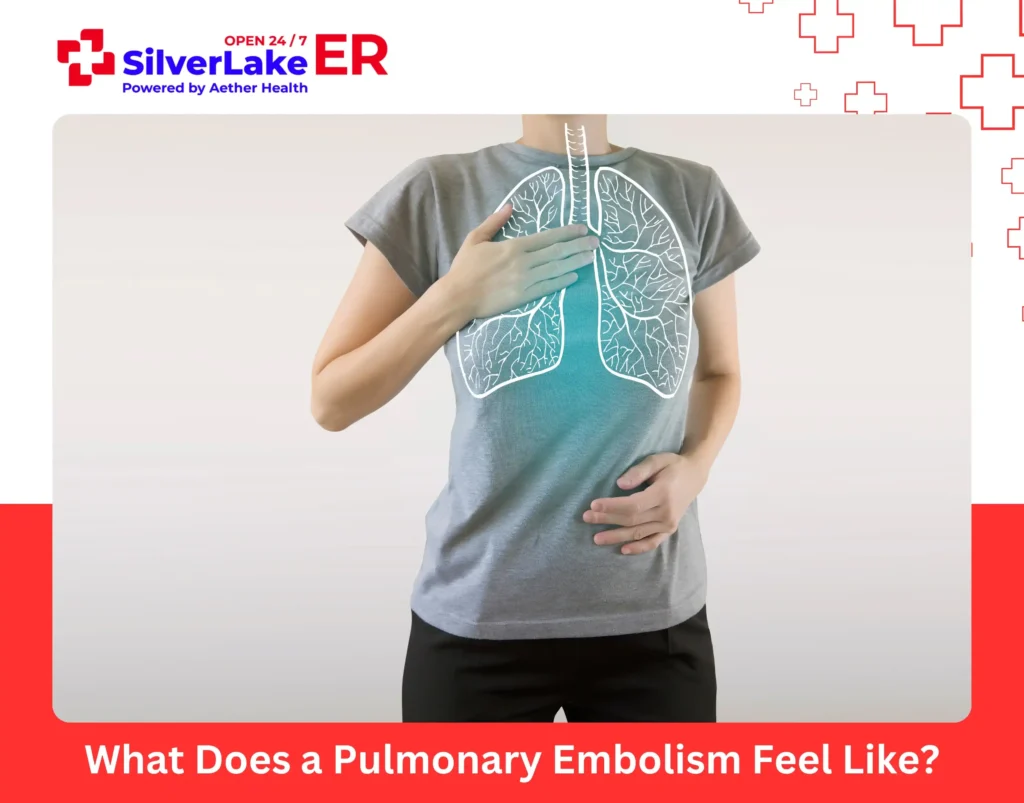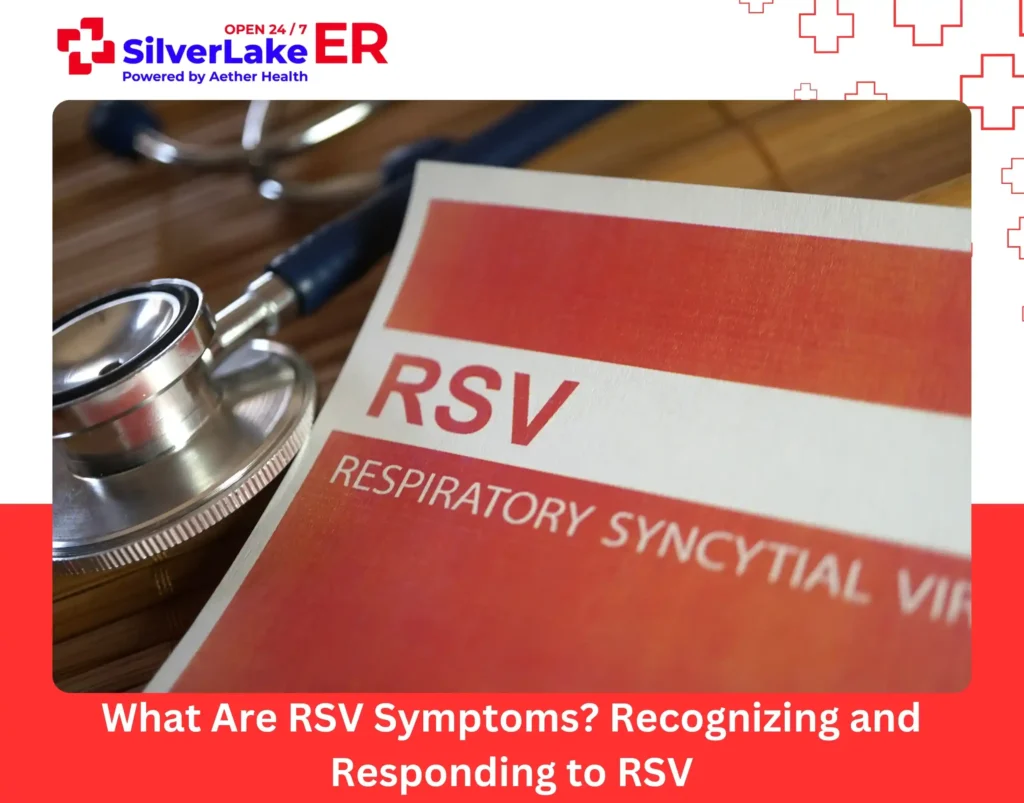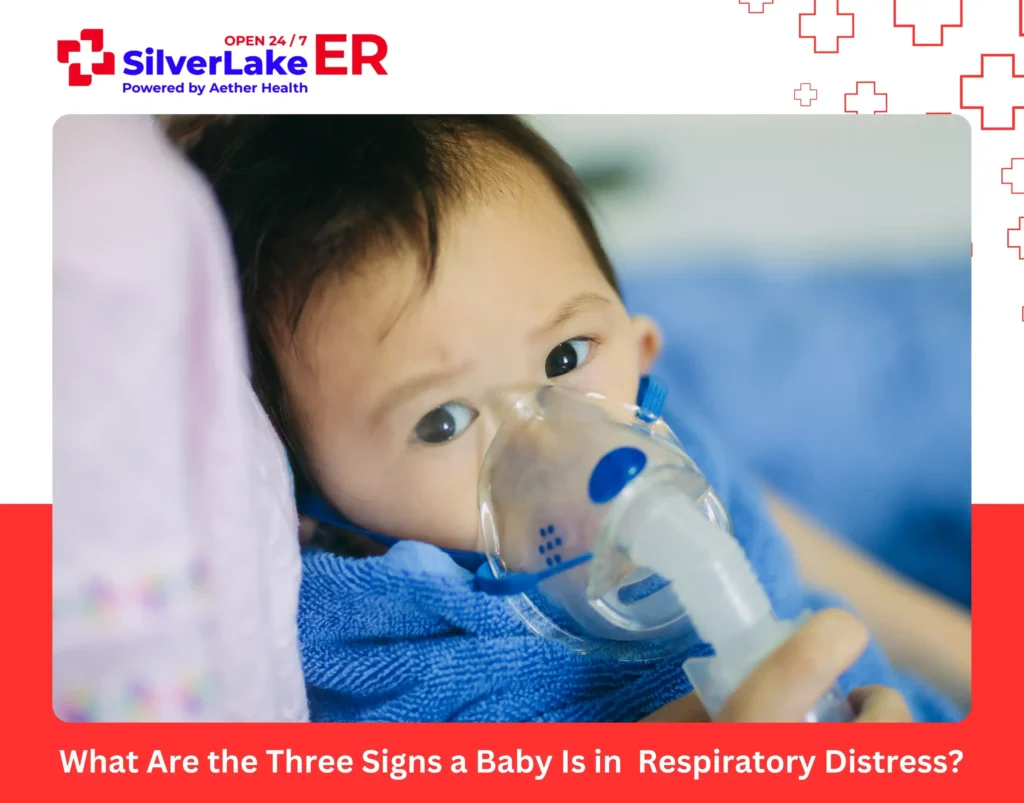What does a pulmonary embolism feel like? It starts with sudden breathlessness, sharp chest pain, and racing heartbeat, but these same symptoms appear in anxiety attacks, pneumonia, and muscle strain.
Nearly 900,000 Americans develop this lung blood clot annually, and the confusion often proves deadly.1 That’s why knowing what a pulmonary embolism feels like could be life-saving.
Doctors can treat a PE quickly if they catch it early. This 5-minute read on ‘what does a pulmonary embolism feel like’ could be the difference between walking out of a hospital and not making it there at all.
What Is a Pulmonary Embolism?
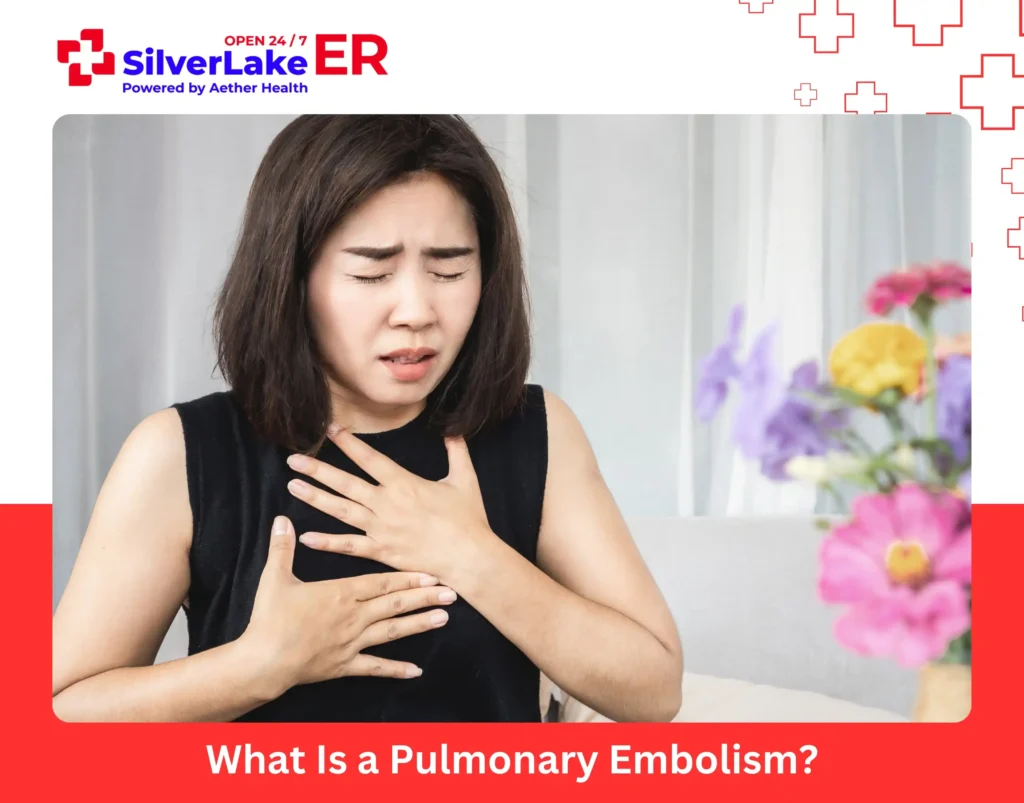
A pulmonary embolism occurs when a blood clot blocks one or more arteries in your lungs, cutting off proper blood flow and oxygen exchange. Think of it as a traffic jam in your lung’s highway system.
Most pulmonary embolisms begin as deep vein thrombosis (DVT), blood clots that form in the deep veins of your legs, pelvis, or arms.
These clots can break free and travel through your bloodstream until they get stuck in the smaller vessels of your lungs, creating the blockage that defines pulmonary embolism.
Why Pulmonary Embolism Feels Different for Everyone
What does a pulmonary embolism feel like depends on several factors:
- Clot size: Small clots may only cause mild shortness of breath, while large ones can quickly become life-threatening, potentially leading to cardiac arrest or death within hours.
- Location: A clot near your lung’s surface causes sharp, stabbing chest pain. One deeper in the lung might start with breathlessness and fatigue. Where it lodges dictates which warning signs appear first.
- Your overall health: People with lung or heart conditions may feel symptoms faster and more severely.
This variability creates a dangerous trap. Some people feel mild discomfort and think they’re fine until it suddenly worsens. Others feel an overwhelming wave of breathlessness and pain right away.
What Does a Pulmonary Embolism Feel Like: 8 Common Symptoms
Understanding the symptoms of pulmonary embolism can significantly improve outcomes.
Primary Symptoms of Pulmonary Embolism
- Sudden Shortness of Breath: This is often the first and most prominent symptom. You find yourself gasping for air even while at rest, or notice that activities that never bothered you before now leave you winded.
- Chest Pain: PE-related chest pain is often sharp and worsens when you take deep breaths, cough, or move. This “pleuritic” chest pain occurs because the blocked blood flow affects the lining around your lungs. Unlike heart attack pain, PE chest pain usually doesn’t radiate to your arm or jaw.
- Rapid Heart Rate: Your heart works overtime trying to compensate for the reduced oxygen in your blood. You may notice your heart racing or feel palpitations, even when you’re not physically active.
- Coughing: A persistent cough, especially one that produces blood or blood-tinged sputum, is a serious warning sign. This happens because the blocked blood vessels can cause bleeding in the lung tissue.
Additional Warning Signs of Pulmonary Embolism
Beyond the primary symptoms, pulmonary embolism can cause several other concerning signs, including:
- Lightheadedness or Fainting: Reduced blood flow can cause dizziness, presyncope (feeling like you’re about to faint), or actual syncope (fainting episodes)
- Leg Swelling or Pain: Since many PEs originate as deep vein thrombosis (DVTs), you may notice swelling, tenderness, or pain in one leg, particularly the calf
- Skin Color Changes: Your skin might appear pale, bluish (cyanotic), or clammy due to decreased oxygen levels
- Excessive Sweating: Breaking out in a cold sweat, especially when combined with other symptoms
Major Risk Factors of Pulmonary Embolism
While pulmonary embolism can strike anyone, certain factors significantly increase your risk.
- Immobility: Extended periods of inactivity top the list of risk factors. This includes long flights, car trips, bed rest after surgery, or prolonged hospitalization. When you don’t move regularly, blood can pool in your legs, which can increase the likelihood of clot formation.
- Recent Surgery or Trauma: Major surgeries, especially orthopedic procedures like hip or knee replacements, significantly increase PE risk. The combination of tissue damage, inflammation, and often prolonged recovery periods creates perfect conditions for clot formation.
- Medical Conditions: Cancer (particularly lung, pancreatic, or blood cancers), heart disease, inflammatory bowel disease, and inherited clotting disorders increases the risk.
- Pregnancy: The risk of pulmonary embolism is highest during late pregnancy and the first 6 weeks after giving birth due to hormonal changes and increased clotting factors.
- Certain Medicines: Hormone-containing birth control pills and hormone replacement therapy increase clotting risk, especially when combined with other risk factors like smoking or prolonged immobility.
- Age: PE risk increases significantly after 40, doubling each decade thereafter.
- Other Factors: Obesity, smoking, and a personal or family history of blood clots also contribute to elevated risk.
If you’re in a high-risk group, knowing symptoms of pulmonary embolism should be a priority.
Pulmonary Embolism Diagnosis
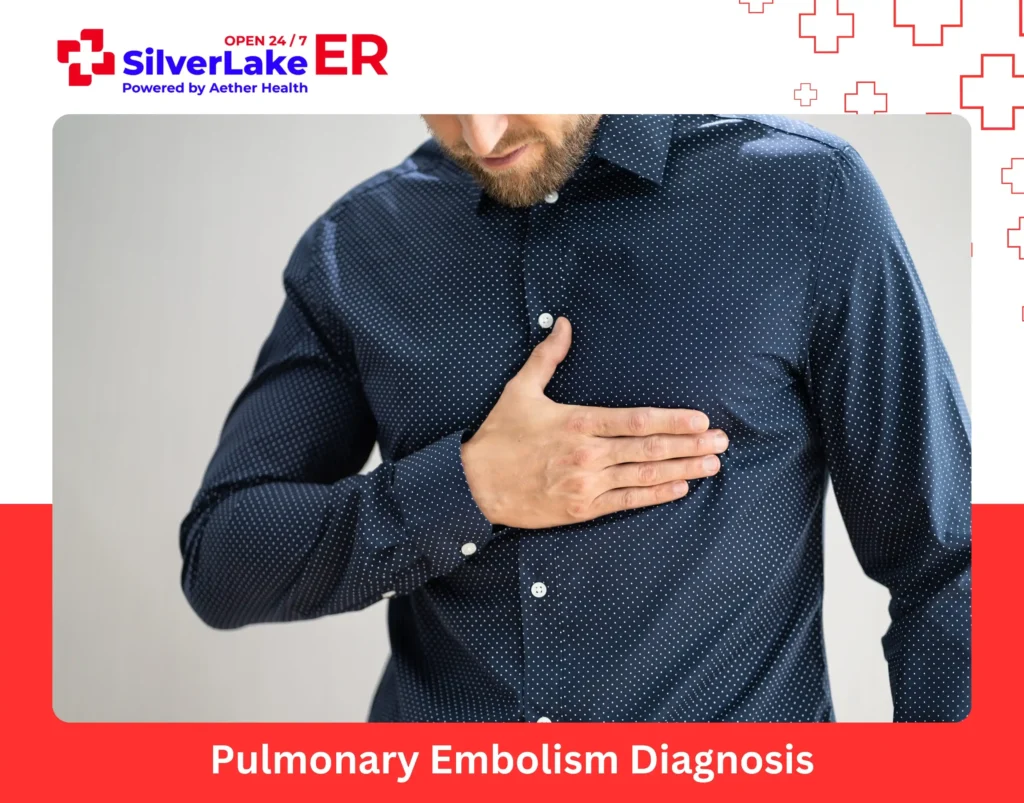
Here’s how pulmonary embolism is diagnosed:
Initial Assessment:
When you visit an emergency department with symptoms, the medical team will check your vital signs, ask about your symptoms and medical history, and perform a physical exam. Based on what they find, they will decide on the best next steps for testing and treatment.
Laboratory Testing:
- D-dimer Test: This blood test measures fragments produced when blood clots break down. While elevated D-dimer levels can suggest clot formation, this test isn’t specific to PE. However, a normal D-dimer in low-risk patients can help rule out PE.
- Arterial Blood Gas: This test measures oxygen and carbon dioxide levels in your blood. PE often causes decreased oxygen levels and specific patterns that support the diagnosis.
- Additional Blood Work: The medical professional may check for signs of heart strain, kidney function, and other factors that influence treatment decisions.
Advanced Imaging:
- CT Pulmonary Angiogram (CTPA): This specialized CT scan with contrast dye is the gold standard for PE diagnosis. It provides detailed images of your lung blood vessels, clearly showing any blockages.
- Ventilation-Perfusion (V/Q) Scan: This nuclear medicine test compares airflow and blood flow in your lungs. It’s particularly useful for patients who can’t receive CT contrast due to kidney problems or allergies.
- Echocardiogram: This ultrasound of your heart can show signs of strain on the right side of your heart, which occurs when PE blocks significant blood flow to your lungs.
Pulmonary Embolism Treatment
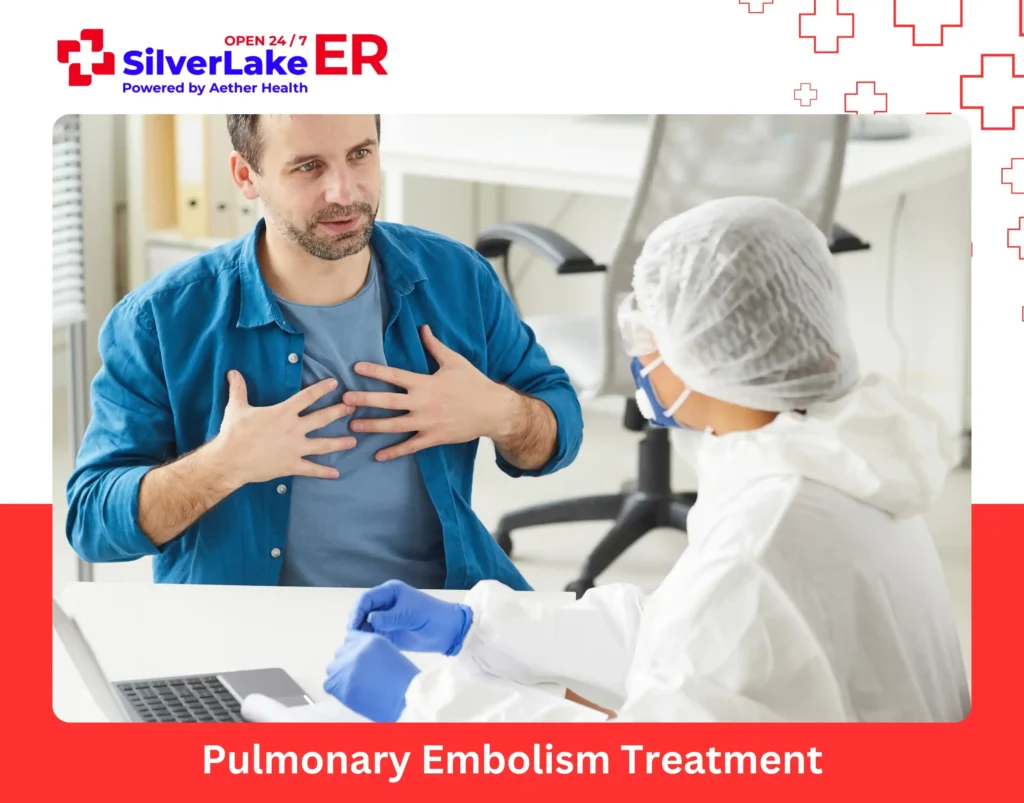
Treatment for PE focuses on stopping clot growth, preventing new clots, and supporting your body as it dissolves the existing clot. Approach depends on PE severity, overall health, and bleeding risk.
Emergency Treatment
- Oxygen Support: Supplemental oxygen if levels are low.
- Anticoagulation Therapy: Blood thinners like heparin or oral anticoagulants are started immediately to stop clot growth and prevent new ones.
Advanced Treatment Options
- Thrombolytic Therapy: “Clot-busting” drugs for life-threatening PE. Used with caution due to bleeding risk.
- Embolectomy: Surgical or catheter-based clot removal in severe cases.
- IVC Filter: For patients who can’t take anticoagulants, a filter may be placed in a large vein to catch clots before they reach the lungs.
Long-term Management
Most patients continue anticoagulation for several months. Follow-up care adjusts treatment based on risk factors and recovery progress.
When to Seek Emergency Care for Pulmonary Embolism
If you have these symptoms, get medical attention right away.
- Sudden shortness of breath
- Chest pain that worsens with deep breathing or coughing
- Coughing up blood or blood-tinged sputum
- Rapid heart rate combined with breathing difficulties
- Fainting or severe lightheadedness
- Sudden leg swelling, pain, or warmth, especially if combined with breathing problems
Final Thoughts: Why Time Matters
A pulmonary embolism, especially a large one or multiple clots, can become deadly in minutes. Knowing what a pulmonary embolism feels like and getting early treatment could save your life or the life of someone you love.
If you experience sudden chest pain, shortness of breath, a rapid heartbeat, or lightheadedness, seek emergency care immediately at Aether Health SilverLake ER. Our advanced imaging and on-site lab services allow us to diagnose and manage pulmonary embolisms, and coordinate seamless transfer for advanced care when necessary.
We’re open 24/7 to provide life-saving care without the long wait times of traditional ERs. Your lungs and your life can’t wait.
FAQs
1. Can a pulmonary embolism happen without any leg pain or swelling?
Yes. While many PEs originate from deep vein thrombosis (DVT) in the legs, some patients never experience noticeable leg symptoms. A PE can occur silently until it reaches the lungs, making early detection difficult.
2. Is it possible to mistake a pulmonary embolism for anxiety or a panic attack?
Absolutely. The symptoms, shortness of breath, chest tightness, and rapid heartbeat, are often misattributed to anxiety, especially in younger or healthy individuals. So, never ignore the warning signs.
3. Are pulmonary embolisms common in women?
Pregnancy, postpartum period, birth control pills, and hormone replacement therapy can all increase the chance of developing a PE, especially in combination with other risks like smoking or a family history of blood clots.
4. Can birth control or hormone therapy increase the risk of PE?
Estrogen-containing medications, such as certain birth control pills and hormone therapy, can increase clotting in the blood.
5. Can you fly after having a pulmonary embolism?
Yes, but timing is important. Most people are advised to wait at least 4 to 6 weeks after a PE before flying. When traveling again, especially on long flights, it’s important to stay hydrated, move your legs frequently, and wear compression stockings.
6. Do lungs heal after pulmonary embolism?
In many cases, the lungs do heal well after a PE, especially if treatment is started quickly. The body can naturally break down the clot over time. However, some people experience lingering symptoms like shortness of breath or fatigue.

